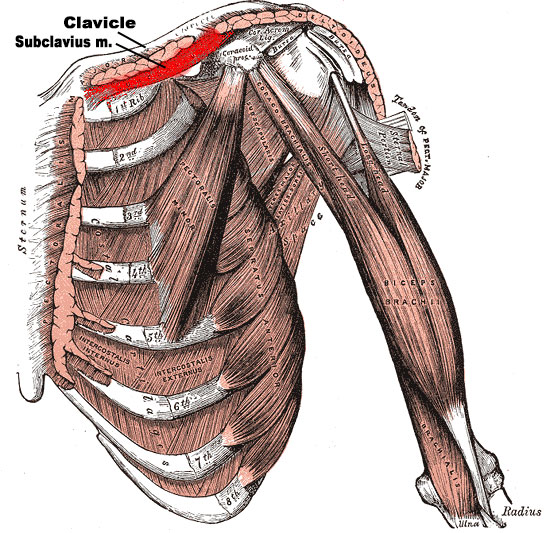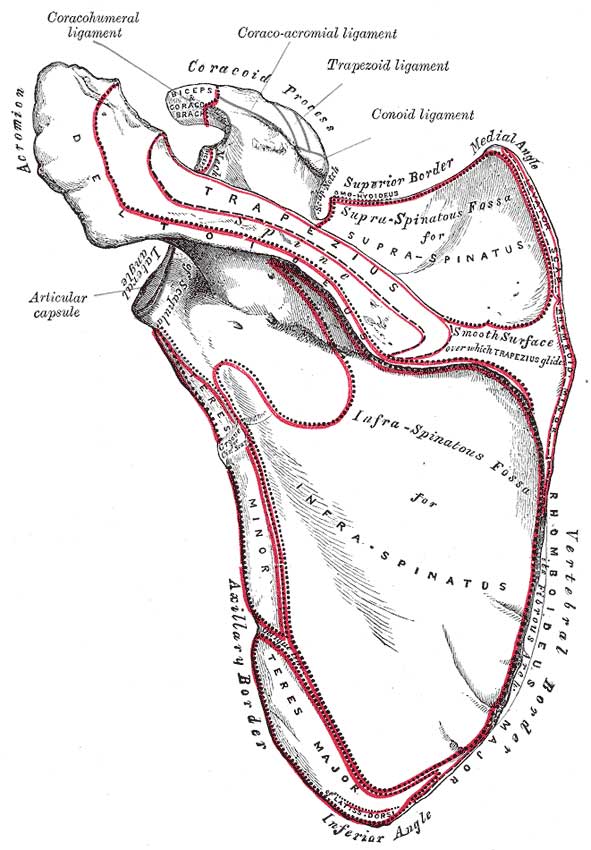
The functions of the subclavius muscle (SM) are described as bringing stabilization of the sternoclavicular joint (SCJ) and resisting elevation of the lateral end of the clavicle. During systematic cadaveric dissections, researchers at published in the Journal of Anatomy that they observed additional fibrous structures at the coracoid process (CP) that appears to be involved in a suspension system that holds up the scapula.
The subclavius muscle is understod depresses the lateral clavicle, acting to stabilize the clavicle while the shoulder moves the arm. raise the first rib while lowering the clavicle during breathing.
The subclavius protects the underlying brachial plexus and subclavian vessels from a broken clavicle – the most frequently broken long bone.
Subclavius
Origin: first rib and cartilage
Insertion: subclavian groove of clavicle (inferior surface of middle one third of the clavicle)
Variations: Insertion into coracoid process instead of clavicle or into both clavicle and coracoid process. Sternoscapular fasciculus to the upper border of scapula. Sternoclavicularis from manubrium to clavicle between pectoralis major and coracoclavicular fascia. Rarely, the subclavius muscle may be missing entirely, and can lead to thoracic outlet syndrome.
Fifty-two upper extremities of 26 human cadavers were dissected. The subclavius muscle was demonstrated from costal to clavicular attachment.
Researchers documented additional fibrous structures apparently derived from the subclavius muscle inserting into the corocoid process, which is a bony process the is connected to the scapula.
In 49 of the 52 specimens researchers found additional fibrous structures passing from the subclavius muscle to the coracoid process. Researcher differentiated three types:
(1) a strong cord-like structure;
(2) a small or thin cord-like structure or structures; and
(3) a planar twisted sheet-like structure.
The researchers discovered that the subclavius muscle and its extension to the coracoid process appears to contribute to a ‘functional scapular suspension system’ together with the other muscles enveloped by the clavipectoral fascia …
pectoralis minor,
coracobrachialis, and
the short head of the biceps brachii.
The suspension system assists in the control of the position of the scapula in relation to the thorax, particularly in elevated positions of the upper extremity.
Researchers speculated that the differentiation of the fibrous structure depends on the functional demands of the individual.
The short head of the pectoralis minor muscle, the biceps brachii muscle, and the coracobrachialis muscle also attach to the corocoid process.
The insertion of the pectoralis minor muscle is connected to the medial border and the superior surface of the coracoid process
The origin of the coracobrachialis muscle is connected to the coracoid process.
The origin of the short head of the biceps brachii connects to the lateral area of the coroacoid process.

Crepaz-Eger U, Lambert S, Hörmann R, Knierzinger D, Brenner E, Hengg C. The anatomy and variation of the coracoid attachment of the subclavius muscle in humans. J Anat. 2021 Oct 25. doi: 10.1111/joa.13548. Epub ahead of print. PMID: 34697796.
